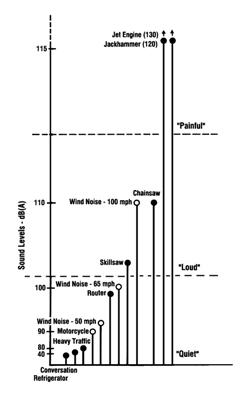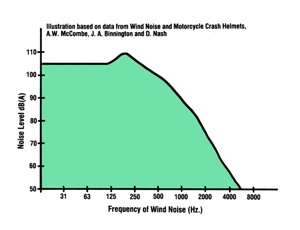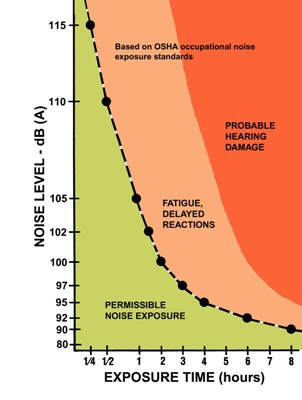If the sound pulses transmitted to the Cochlea are very loud, the
sudden pressure can break off the receptor hair one by one,
gradually diminishing hearing. Repeated loud noises will gradually
break off more and more receptor hairs. The position of the
receptors in the Cochlea determines the frequency range. If there is
constant high volume noise in a certain frequency range, you will
gradually go deaf in that range. The problem is that the little
receptor hairs in the Cochlea don't grow back. Once they snap off,
they are just useless debris, like broken cylinder fins. And let's
note that big, bad bikers don't have stronger Cochlea hairs than
anyone else. Toughing out a noisy ride won't prevent hearing loss.
 Wind Noise
Wind Noise
It turns out that wind noise is at a low frequency—more like the
rumble of a bass drum. The low frequency fools the brain into
ignoring it, even while some of those little hearing receptors are
getting snapped off. What's really insidious about wind noise is
that the brain learns to ignore it, even as your hearing is being
damaged. It doesn't hurt when a hearing receptor snaps off.
How loud is wind noise? Tom Mehren and I had a chance to do some
measuring with a sound meter stuck out of an open car window. We
found that the noise level was around 100 dB(A) at speeds over about
50 mph. The noise didn't increase when we passed a noisy truck, and
it decreased with the window rolled up, so we have to conclude that
the loud source was mostly wind noise. Our measurements agreed with
what the noise researchers have found.
Tom's meter didn't give us the option of measuring frequency. But
some researchers in England carefully measured wind level, and
determined that wind noise is very loud at low frequencies, drops
off steadily after about 250 cycles per second ("Hz") and goes quiet
by about 6000 Hz.
 Exposure Limits
Exposure Limits
OK, we have to believe that wind noise is potentially damaging.
But do I have to wear hearing protection while riding around town,
or for a half-hour run on the freeway? OSHA considers noise level
and exposure time, and has a chart that applies to motorcycling as
much as to industrial jobs. No, you don't have to wear earplugs at
speeds under about 40 mph, even for several hours. And for speeds
over 55 mph, you can tolerate up to about 2 hours and still be
within OSHA limits. But if you're going to ride more than two hours
at greater than about 55 mph, you'll need hearing protection to
avoid damage.
 Doesn't a high priced helmet reduce wind noise?
Doesn't a high priced helmet reduce wind noise?
The shape of a helmet shell, and the smooth fit of a faceshield
can reduce buffeting, but air is constantly moving around the
helmet, and it generates noise. The noise doesn't necessarily travel
in the same direction as the air. And some helmet components can
actually generate noise. I'm skeptical of any advertizing claims
about a helmet being "quiet." I have yet to see any noise testing of
helmets that proves any attenuation in the wind noise frequencies.
With that background in how wind around your helmet relates to
hearing damage, stay tuned for Part 2, where we'll discuss the
different types of earplugs and how to use them.
Click here to read Part 2
David Hough
is a long-time motorcyclist and journalist. His work has appeared in numerous motorcycle publications, but he is best known for the monthly skills series "
Proficient Motorcycling
" in Motorcycle Consumer News, which has been honored by special awards from the Motorcycle Safety Foundation. Selected columns were edited into
two books
Proficient Motorcycling
and
More Proficient Motorcycling
, both published by Bowtie Press. He is also the author of
Driving A Sidecar Outfit and a pocket riding skills handbook,Street Strategies
.


